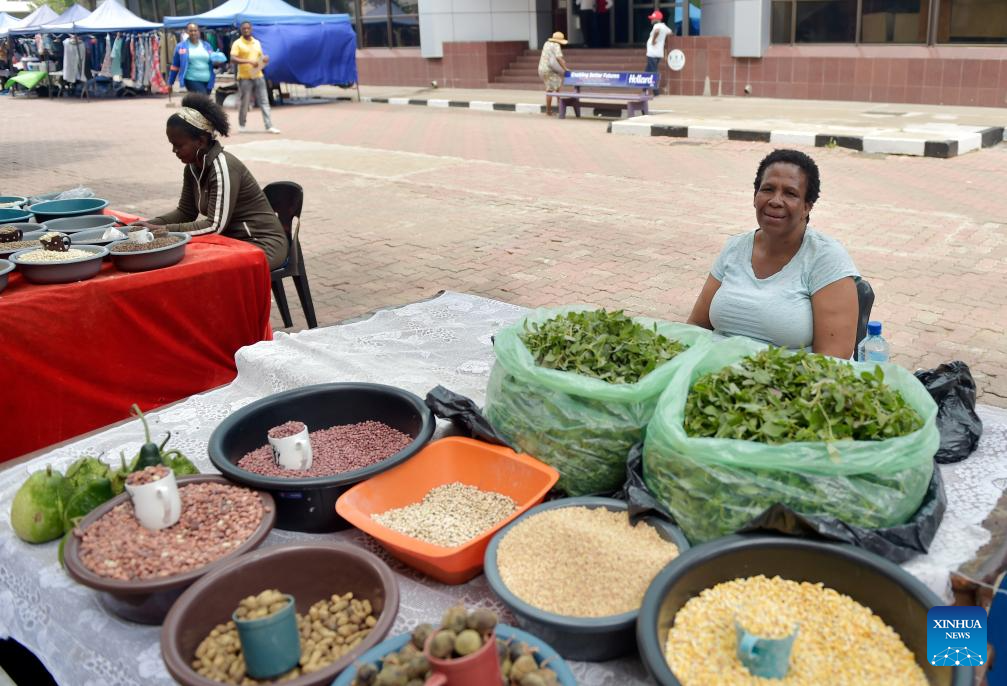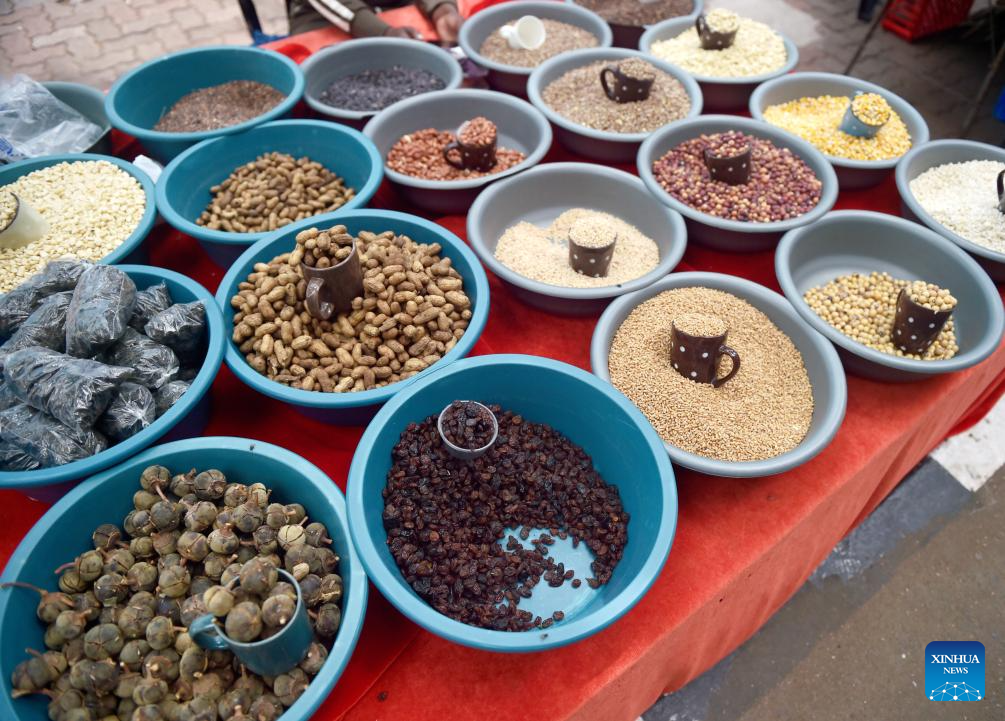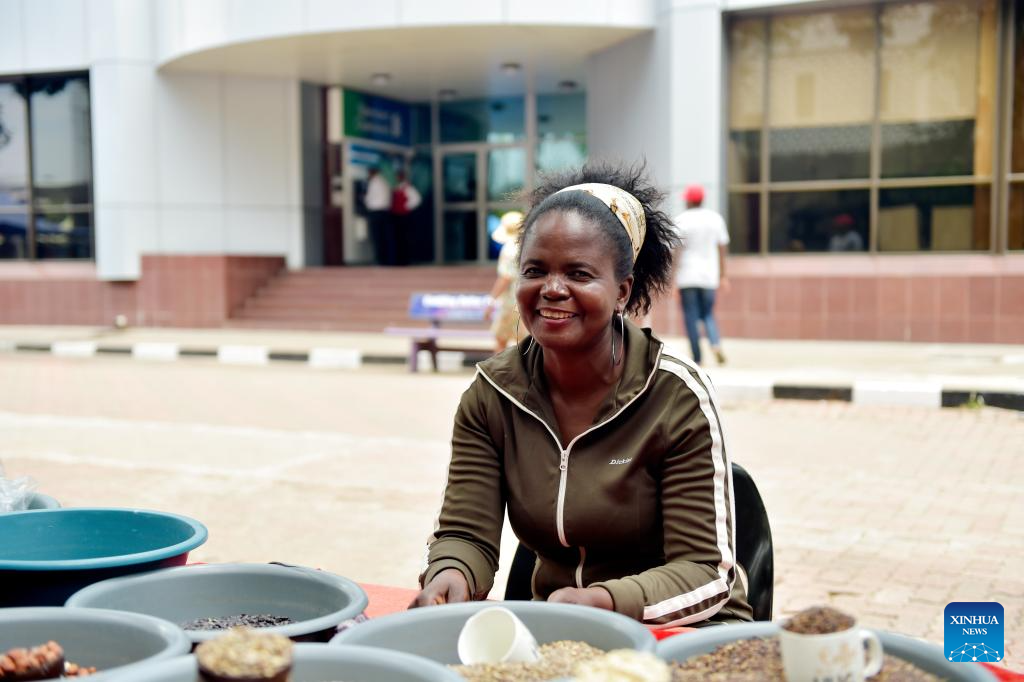
Lesego Tshidi Motshegaletau (R), an indigenous food vendor, sells traditional food in the Main Mall market in Gaborone, Botswana, on Nov. 16, 2023. In the bustling city of Gaborone, the capital of Botswana, lies Main Mall, one of the oldest and most eclectic markets in the country. Built in 1963, this vibrant marketplace is home to prolific hawkers, merchants and food vendors, offering a diverse array of flavors and colors amid high-rise concrete buildings. (Photo by Tshekiso Tebalo/Xinhua)
GABORONE, Dec. 1 (Xinhua) -- In the bustling city of Gaborone, the capital of Botswana, lies Main Mall, one of the oldest and most eclectic markets in the country.
Built in 1963, this vibrant marketplace is home to prolific hawkers, merchants and food vendors, offering a diverse array of flavors and colors amid high-rise concrete buildings.
Lesego Tshidi Motshegaletau, an indigenous food vendor, owns a traditional food stall within this cosmopolitan market. Her stall is a burst of colorful and flavorful offerings, including Sorghum bran, rice, millet, wheat, tea, a variety of beans and amaranths.
Motivated by economic hardships, Motshegaletau started her business in 2005. In an interview with Xinhua, she said: "I had a passion for our food (Tswana traditional cuisine) and the way they are, more especially that I have hypertension and arthritis, so they have certain benefits for other diseases."
Residing in Thamaga village, about 40 km west of Gaborone, 47-year-old Motshegaletau said that her business is crucial for supporting her family, enabling her to contribute to her children's education. Monthly she is able to make 5,000 pula (about 370 U.S. dollars)
Motshegaletau is a small-scale farmer who gets her produce from her farm in Thamaga and Ramasenyane village. She travels to different locations across the country to buy other products.
Recognizing the seasonal nature of her produce and grains, Motshegaletau encounters difficulties during the off-season when facing increased expenses for stocking. She strongly advocates for government aid, calling for financial support or loans to tackle shortages during this period.
Highlighting the health benefits of traditional foods, she emphasized the demand for African tea, Mowana and amaranths. She said: "Traditional foods are important because they are not processed, they are eaten the way they are as intended by nature, and they have important benefits."
In a country burdened by communicable and non-communicable diseases (NCDs), Botswana has a mortality rate of 934 per 100,000 in males and 712 in females for major NCDs, according to the World Health Organization's country disease outlook 2023.
Botswana's Health Ministry encourages embracing healthy habits, including consuming nutritious diets that incorporate indigenous cuisine.
Omphile Rasedi, a customer from Kumakwane village, located 25 km west of Gaborone, said that she prefers traditional foods since they are organic and develop organically without the use of pesticides.
John Nderitu, a dietitian at Bokamoso Private Hospital, underlines the importance of healthy eating, emphasizing the consumption of fiber-rich foods and less refined starches. He advises incorporating green leafy vegetables, perennial kale, amaranths, okra, and dark green vegetables into the diet for overall well-being. ■

Photo taken on Nov. 16, 2023 shows traditional food sold in the Main Mall market in Gaborone, Botswana. In the bustling city of Gaborone, the capital of Botswana, lies Main Mall, one of the oldest and most eclectic markets in the country. Built in 1963, this vibrant marketplace is home to prolific hawkers, merchants and food vendors, offering a diverse array of flavors and colors amid high-rise concrete buildings. (Photo by Tshekiso Tebalo/Xinhua)

An indigenous food vendor sells traditional food in the Main Mall market in Gaborone, Botswana, on Nov. 16, 2023. In the bustling city of Gaborone, the capital of Botswana, lies Main Mall, one of the oldest and most eclectic markets in the country. Built in 1963, this vibrant marketplace is home to prolific hawkers, merchants and food vendors, offering a diverse array of flavors and colors amid high-rise concrete buildings. (Photo by Tshekiso Tebalo/Xinhua)
